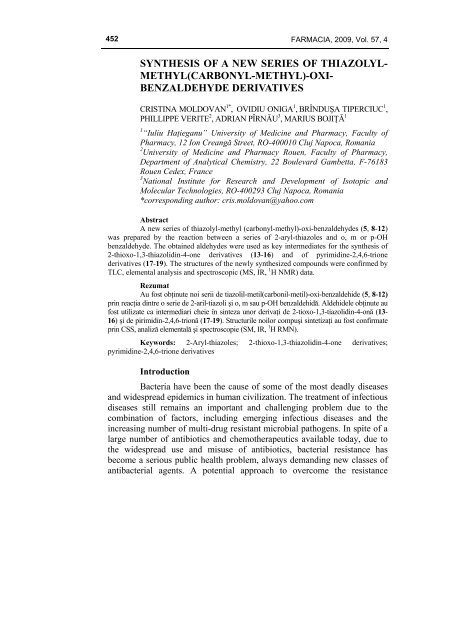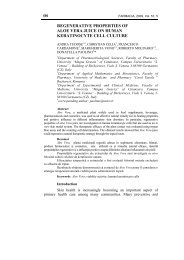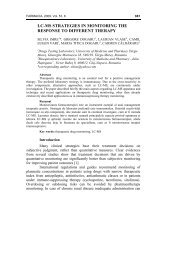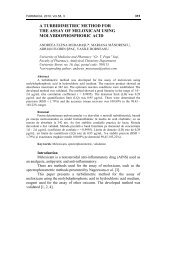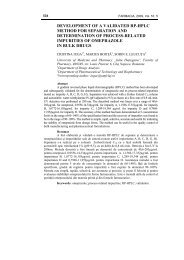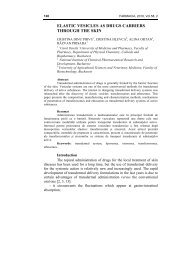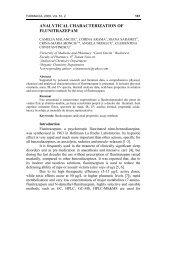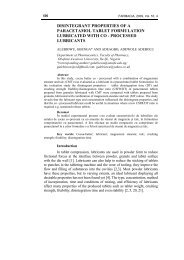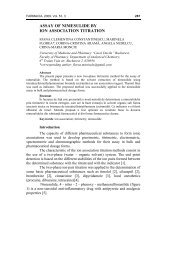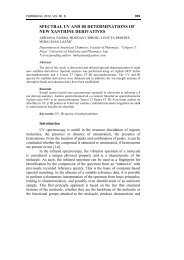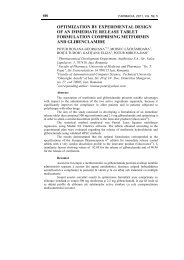synthesis of a new series of thiazolyl- methyl(carbonyl ... - farmacia
synthesis of a new series of thiazolyl- methyl(carbonyl ... - farmacia
synthesis of a new series of thiazolyl- methyl(carbonyl ... - farmacia
Create successful ePaper yourself
Turn your PDF publications into a flip-book with our unique Google optimized e-Paper software.
452<br />
FARMACIA, 2009, Vol. 57, 4<br />
SYNTHESIS OF A NEW SERIES OF THIAZOLYL-<br />
METHYL(CARBONYL-METHYL)-OXI-<br />
BENZALDEHYDE DERIVATIVES<br />
CRISTINA MOLDOVAN 1* , OVIDIU ONIGA 1 , BRÎNDUŞA TIPERCIUC 1 ,<br />
PHILLIPPE VERITE 2 , ADRIAN PÎRNĂU 3 , MARIUS BOJIŢĂ 1<br />
1 “Iuliu Haţieganu” University <strong>of</strong> Medicine and Pharmacy, Faculty <strong>of</strong><br />
Pharmacy, 12 Ion Creangă Street, RO-400010 Cluj Napoca, Romania<br />
2 University <strong>of</strong> Medicine and Pharmacy Rouen, Faculty <strong>of</strong> Pharmacy,<br />
Department <strong>of</strong> Analytical Chemistry, 22 Boulevard Gambetta, F-76183<br />
Rouen Cedex, France<br />
3 National Institute for Research and Development <strong>of</strong> Isotopic and<br />
Molecular Technologies, RO-400293 Cluj Napoca, Romania<br />
*corresponding author: cris.moldovan@yahoo.com<br />
Abstract<br />
A <strong>new</strong> <strong>series</strong> <strong>of</strong> <strong>thiazolyl</strong>-<strong>methyl</strong> (<strong>carbonyl</strong>-<strong>methyl</strong>)-oxi-benzaldehydes (5, 8-12)<br />
was prepared by the reaction between a <strong>series</strong> <strong>of</strong> 2-aryl-thiazoles and o, m or p-OH<br />
benzaldehyde. The obtained aldehydes were used as key intermediates for the <strong>synthesis</strong> <strong>of</strong><br />
2-thioxo-1,3-thiazolidin-4-one derivatives (13-16) and <strong>of</strong> pyrimidine-2,4,6-trione<br />
derivatives (17-19). The structures <strong>of</strong> the <strong>new</strong>ly synthesized compounds were confirmed by<br />
TLC, elemental analysis and spectroscopic (MS, IR, 1 H NMR) data.<br />
Rezumat<br />
Au fost obţinute noi serii de tiazolil-metil(carbonil-metil)-oxi-benzaldehide (5, 8-12)<br />
prin reacţia dintre o serie de 2-aril-tiazoli şi o, m sau p-OH benzaldehidă. Aldehidele obţinute au<br />
fost utilizate ca intermediari cheie în sinteza unor derivaţi de 2-tioxo-1,3-tiazolidin-4-onă (13-<br />
16) şi de pirimidin-2,4,6-trionă (17-19). Structurile noilor compuşi sintetizaţi au fost confirmate<br />
prin CSS, analiză elementală şi spectroscopie (SM, IR, 1 H RMN).<br />
Keywords: 2-Aryl-thiazoles; 2-thioxo-1,3-thiazolidin-4-one derivatives;<br />
pyrimidine-2,4,6-trione derivatives<br />
Introduction<br />
Bacteria have been the cause <strong>of</strong> some <strong>of</strong> the most deadly diseases<br />
and widespread epidemics in human civilization. The treatment <strong>of</strong> infectious<br />
diseases still remains an important and challenging problem due to the<br />
combination <strong>of</strong> factors, including emerging infectious diseases and the<br />
increasing number <strong>of</strong> multi-drug resistant microbial pathogens. In spite <strong>of</strong> a<br />
large number <strong>of</strong> antibiotics and chemotherapeutics available today, due to<br />
the widespread use and misuse <strong>of</strong> antibiotics, bacterial resistance has<br />
become a serious public health problem, always demanding <strong>new</strong> classes <strong>of</strong><br />
antibacterial agents. A potential approach to overcome the resistance
FARMACIA, 2009, Vol. 57, 4 453<br />
problem may be represented by the design <strong>of</strong> innovative agents having a<br />
different mechanism <strong>of</strong> action, so that it can’t occur any cross-resistance<br />
with the therapeutic agents in use.<br />
In the family <strong>of</strong> heterocyclic compounds, nitrogen-containing<br />
heterocycles with a sulfur atom represent an important class <strong>of</strong> compounds<br />
in the medicinal chemistry. Thiazoles and their derivatives have attracted<br />
continuing interest over the decades because <strong>of</strong> their varied biological<br />
activities: antibacterial [1-3], antiviral [4], antifungal [5], treatment <strong>of</strong><br />
allergies, pain, hypertension, inflammation, schizophrenia, HIV infections,<br />
hypnotics, fibrinogen receptor antagonists with antithrombotic activity [6].<br />
Apart from these, thiazolidin-4-ones show an antitumor [7,8],<br />
antituberculosis, anticonvulsant [9] activity. Data from literature report that<br />
the entrance <strong>of</strong> arylidene moieties at different positions <strong>of</strong> the 1,3-<br />
thiazolidine ring enhanced the antimicrobial activity [10,11].<br />
Pyrimidine 2,4,6–trione derivatives exert important action on the<br />
central nervous system, and recently have been found totally <strong>new</strong> biomedicinal<br />
applications in fields such as cancer (possess a marked inhibitory activity<br />
against the matrix metalloproteinases and showed antimetastatic and antitumor<br />
activity [12]) and AIDS therapy, and protease inhibitors [13].<br />
As part <strong>of</strong> our ongoing studies in developing <strong>new</strong> active<br />
antimicrobials [14-20], we report the <strong>synthesis</strong> <strong>of</strong> 3 <strong>new</strong> <strong>series</strong> <strong>of</strong><br />
structurally novel 2-aryl-thiazoles, various substituted in the 4 or 5 position<br />
with different voluminous fragments incorporating 2-thioxo-1,3-<br />
thiazolidine-4-one or pyrimidine 2,4,6–trione moieties.<br />
Materials and methods<br />
General Procedures. All reagents and solvents were obtained<br />
from commercial sources. According to literature protocols there were<br />
prepared: 4-<strong>methyl</strong>-2-phenyl-5-bromoacetyl-thiazole [21] and 2-aryl-4-<br />
iodo<strong>methyl</strong>-thiazole [22]. Analytical thin layer chromatography (TLC) was<br />
carried out on precoated Silica Gel 60F 254 sheets using UV absorption for<br />
visualization. The melting points were taken with two melting point meters,<br />
Electrothermal and MPM-H1 Schorpp and were uncorrected. FT-IR spectra<br />
were recorded on a Nicolet 210 FT-IR spectrometer with a MCT detector<br />
and an Omnic 4.1b s<strong>of</strong>t system, using potassium bromide. The 1 HNMR<br />
spectra were recorded at room temperature on a Bruker Avance NMR<br />
spectrometer operating at 500 MHz. Chemical shift values were reported<br />
relative to tetra<strong>methyl</strong>silane (TMS) as internal standard. The samples were<br />
prepared by dissolving the synthesized powder <strong>of</strong> the compounds in DMSOd6<br />
(δ H = 2.51ppm) as solvent and the spectra were recorded using a single
454<br />
FARMACIA, 2009, Vol. 57, 4<br />
excitation pulse <strong>of</strong> 12 µs. GC-MS analyses were performed with an Agilent<br />
gas chromatograph 6890 equipped with an apolar Macherey Nagel<br />
Permabond SE 52 capillary column. Elemental analysis was registered with<br />
a Vario El CHNS instrument.<br />
4-[2-(4-Methyl-2-phenyl-thiazole-5-yl)-2-oxo-ethoxy]-benzaldehyde (5).<br />
To a mixture <strong>of</strong> p-OH-benzaldehyde (0.488 g, 4 mmol) and K 2 CO 3 anhydrous<br />
(1.65 g, 12 mmol) in dry acetone (20mL) was added the 4-<strong>methyl</strong>-2-phenyl-5-<br />
bromoacetyl-thiazole 4 (1.18 g, 4 mmol). The mixture was heated on a water<br />
bath, in anhydrous conditions, for 5 h. The reaction mixture was afterwards<br />
poured on water with ice. The precipitate was filtered <strong>of</strong>f and washed with<br />
water (50 mL) to obtain the aldehyde 5 (0.852 g, 63.2%). Brown solid. Mp =<br />
132-135 o C. 1 H NMR (500 MHz, DMSO-d6): δ ppm = 2.7 (s, 3H, CH 3 ), 5.4 (s,<br />
2H, CH 2 ), 7.1 (d, 2H, 2H a’ -arom), 7.53-7.64 (m, 3H, 2H a -arom, H-paraC 6 H 5 -<br />
), 8.00 (d, 2H, 2H b -arom), 8.2 (d, 2H, H b’ -arom), 10 (s, 1H, CHO). IR (KBr):<br />
ν= 3060 (CH arom ), 2918 and 2850 (CH aliph ), 1698 (C=O), 1652 (C=O, CHO),<br />
1643 (C=N), 1590 (C=C) cm -1 . Anal.Calcd.(%) for C 19 H 15 NO 3 S (Molec.<br />
Mass: 337.39, Exact Mass: 337.077): C67.64, H4.48, N4.15, S9.5. Found:<br />
C67.45, H4.47, N4.14, S9.53. MS (EI, 70eV): m/z (%) 337 (28), 202 (100),<br />
174 (15), 121 (5), 104 (5), 71 (12).<br />
2-[2-(4-Bromo-phenyl)-thiazol-4-ylmethoxy]-benzaldehyde (8). To a<br />
mixture <strong>of</strong> o-OH-benzaldehyde (0.366 g, 3 mmol) and K 2 CO 3 anhydrous<br />
(1.242 g, 9 mmol) in dry acetone (15 mL) was added the 2-(4-Bromophenyl)-4-iodo<strong>methyl</strong>-thiazole<br />
6 (1.13 g, 3 mmol). The mixture was heated<br />
on a water bath, in anhydrous conditions, for 3 h. The reaction mixture was<br />
afterwards cooled; the precipitate was filtered <strong>of</strong>f to obtain the aldehyde 8<br />
(0.87g, 77.54%). White solid. Mp = 148-150 o C. 1 H NMR (500 MHz,<br />
DMSO-d6): δ ppm = 5.3 (s, 2H, CH 2 ), 7.1 (t, 1H, H-paraC 6 H 5 -), 7.26 (d, 1H,<br />
H a ’-arom), 7.38 (d, 2H, H b -arom), 7.51 (t, 1H, H b’ -arom), 7.6 (s, 1H,<br />
Hthiazole ), 7.85 (d, 2H, H a -arom), 7.9 (d, 1H, H a’’ -arom), 10.45 (s, 1H,<br />
CHO). IR (KBr): ν= 3063 (CH arom ), 2919 (CH aliph ), 1670 (C=O, CHO),<br />
1640 (C=N), 1593 (C=C), 1071 (C-Br) cm -1 . Anal.Calcd.(%) for<br />
C 17 H 12 BrNO 2 S (Molec. Mass: 374.25, Exact Mass: 372.977): C54.56,<br />
H3.23, N3.74, S8.57. Found: C54.44, H3.2, N3.73, S8.59. MS (EI, 70 eV):<br />
m/z (%) 375 (9), 373 (9), 252 (100), 254 (100), 182 (9), 180 (9), 71 (38).<br />
3-[2-(4-Bromo-phenyl)-thiazol-4-ylmethoxy]-benzaldehyde (9). To a<br />
mixture <strong>of</strong> m-OH-benzaldehyde (0.366 g, 3 mmol) and K 2 CO 3 anhydrous<br />
(1.242 g, 9 mmol) in dry acetone (15 mL) was added the 2-(4-Bromophenyl)-4-iodo<strong>methyl</strong>-thiazole<br />
6 (1.14 g, 3 mmol). The mixture was heated<br />
on a water bath, in anhydrous conditions, for 3 h. The reaction mixture was<br />
afterwards cooled; the precipitate was filtered <strong>of</strong>f to obtain the aldehyde 9
FARMACIA, 2009, Vol. 57, 4 455<br />
(0.922g, 82.17%). Yellow solid. Mp = 135-137 o C. 1 H NMR (500 MHz,<br />
DMSO-d6): δ ppm = 5.1 (s, 2H, CH 2 ), 6.657 (d, 1H, H a’’ -arom), 6.78 (d, 1H,<br />
H’-paraC 6 H 5 -), 7.105 (t, 1H, H b’ -arom), 7.624 (s, 1H, H a’ -arom ), 7.798 (s,<br />
1H, Hthiazole), 7.871 (d, 2H, 2H b -arom), 7.92 (d, 2H, 2H a -arom), 10.2 (s,<br />
1H, CHO). IR (KBr): ν= 3061 (CH arom ), 2926 (CH aliph ), 1698 (C=O, CHO),<br />
1638 (C=N), 1600 (C=C), 1070 (C-Br) cm -1 . Anal.Calcd.(%) for<br />
C 17 H 12 BrNO 2 S (Molec. Mass: 374.25, Exact Mass: 372.97): C54.56, H3.23,<br />
N3.74, S8.57. Found: C54.39, H3.215, N3.73, S8.54. MS (EI, 70 eV): m/z<br />
(%) 375 (9), 373 (9), 252 (100), 254 (100), 182 (9), 180 (9), 71 (38).<br />
4-[2-(4-Bromo-phenyl)-thiazol-4-ylmethoxy]-benzaldehyde (10). To a<br />
mixture <strong>of</strong> p-OH-benzaldehyde (0.366 g, 3 mmol) and K 2 CO 3 anhydrous<br />
(1.242 g, 9 mmol) in dry acetone (15 mL) was added the 2-(4-Bromophenyl)-4-iodo<strong>methyl</strong>-thiazole<br />
6 (1.13 g, 3 mmol). The mixture was heated<br />
on a water bath, in anhydrous conditions, for 3 h. The reaction mixture was<br />
afterwards cooled; the precipitate was filtered <strong>of</strong>f to obtain the aldehyde 10<br />
(0.91g, 81.10%). Brown solid. Mp = 137-139 o C. 1 H NMR (500 MHz,<br />
DMSO-d6): δ ppm = 5.3 (s, 2H, CH 2 ), 7.272 (d, 2H, 2H a’ -arom), 7.52 (d, 2H,<br />
2H b -arom), 7.61 (d, 2H, 2H a -arom), 7.834 (s, 1H, Hthiazole), 7.968 (d, 2H,<br />
H b’ -arom), 10 (s, 1H, CHO). IR (KBr): ν= 3058 (CH arom ), 2921 (CH aliph ),<br />
1697 (C=O, CHO), 1635 (C=N), 1589 (C=C), 1071 (C-Br) cm -1 .<br />
Anal.Calcd.(%) for C 17 H 12 BrNO 2 S (Molec. Mass: 374.25, Exact Mass:<br />
372.97): C54.56, H3.23, N3.74, S8.57. Found: C54.41, H3.22, N3.73,<br />
S8.565. MS (EI, 70 eV): m/z (%) 375 (9), 373 (9), 252 (100), 254 (100),<br />
182 (9), 180 (9), 71 (38).<br />
3-(2-Phenyl-thiazol-4-ylmethoxy)-benzaldehyde (11). To a mixture <strong>of</strong> m-<br />
OH-benzaldehyde (0.244 g, 2 mmol) and K 2 CO 3 anhydrous (0.828 g, 6<br />
mmol) in dry acetone (10 mL) was added the 2-phenyl-4-iodo<strong>methyl</strong>thiazole<br />
7 (0.6 g, 2 mmol). The mixture was heated on a water bath, in<br />
anhydrous conditions, for 3 h. The reaction mixture was afterwards cooled<br />
and poured on water. The obtained precipitate was filtered <strong>of</strong>f to obtain 11<br />
(0.53 g, 71.23%). Yellow solid. Mp = 67-70 o C.<br />
1 H NMR (500 MHz,<br />
DMSO-d6): δ ppm = 5.25 (s, 2H, CH 2 ), 7.62 (s, 1H, H a’ -arom), 7.82 (s, 1H,<br />
Hthiazole ), 7.96 (d, 2H, H b -arom), 10.00 (s, 1H, CHO). IR (KBr): ν= 3043<br />
(CH arom ), 2922 (CH aliph ), 1682 (C=O, CHO), 1609 (C=N), 1593 (C=C) cm -1 .<br />
Anal.Calcd.(%) for C 17 H 13 NO 2 S (Molec. Mass: 295.35, Exact Mass:<br />
295.066): C69.13, H4.44, N4.74, S10.85. Found: C68.87, H4.43, N4.73,<br />
S10.83. MS (EI, 70 eV): m/z (%) 295 (18), 174 (100), 121 (14), 71 (17).<br />
4-(2-Phenyl-thiazol-4-ylmethoxy)-benzaldehyde (12). To a mixture <strong>of</strong> p-<br />
OH-benzaldehyde (1.22 g, 10 mmol) and K 2 CO 3 anhydrous (4.14 g, 30<br />
mmol) in dry acetone (50 mL) was added the 2-phenyl-4-iodo<strong>methyl</strong>-
456<br />
FARMACIA, 2009, Vol. 57, 4<br />
thiazole 7 (3 g, 10 mmol). The mixture was heated on a water bath, in<br />
anhydrous conditions, for 5 h. The reaction mixture was afterwards cooled<br />
and poured on water. The obtained precipitate was filtered <strong>of</strong>f to obtain 12<br />
(2.91g, 78.22%). White solid. Mp = 82-84 o C. 1 H NMR (500 MHz, DMSOd6):<br />
δ ppm = 5.3 (s, 2H, CH 2 ), 7.1 (d, 2H, H a’ -arom), 7.51-7.52 (m, 3H, 2H a -<br />
arom, H-paraC 6 H 5 -), 7.59 (d, 2H, H b’ -arom), 7.83 (s, 1H, Hthiazole), 10.00<br />
(s, 1H, CHO). IR (KBr): ν= 3047 (CH arom ), 2922 (CH aliph ), 1682 (C=O,<br />
CHO), 1615 (C=N), 1593 (C=C) cm -1 . Anal.Calcd.(%) for C 17 H 13 NO 2 S<br />
(Molec. Mass: 295.35, Exact Mass: 295.066): C69.13, H4.44, N4.74,<br />
S10.85. Found: C68.92, H4.43, N4.75, S10.812. MS (EI, 70 eV): m/z (%)<br />
295 (18), 174 (100), 121 (14), 71 (17).<br />
5-{4-[2-(4-Methyl-2-phenyl-thiazol-5-yl)-2-oxo-ethoxy]-benzylidene}-2-<br />
thioxo-thiazolidin-4-one (13). To a mixture <strong>of</strong> 2-thioxo-1,3-thiazolidin-4-<br />
one (0.133 g, 1 mmol) and anhydrous sodium acetate (0.246 g, 3 mmol) in<br />
glacial acetic acid (5 mL) was added the compound 5 (0.337 g, 1 mmol).<br />
The mixture was heated for 6 h, afterwards cooled and the obtained<br />
precipitate was filtered <strong>of</strong>f and washed with water (100mL) to obtain 13<br />
(0.275 g, 60.84%). Yellow solid. Mp = 232-238 o C. 1 H NMR (500 MHz,<br />
DMSO-d6): δ ppm = 2.77 (s, 3H, CH 3 ), 5.47 (s, 2H, CH 2 ), 7.18 (d, 2H, H a ’-<br />
arom), 7.56 (s, 1H, CH), 7.57 (d, 2H, H b ’-arom), 7.59 (t, 1H, H-paraC 6 H 5 -),<br />
7.82 (t, 2H, H a -arom), 8.04 (d, 2H, H b -arom) 13-14.5 (brs, 1H, NH). IR<br />
(KBr): ν= 3432 (NH), 3058 (CH arom ), 2918 and 2851 (CH aliph ), 1692 (C=O),<br />
1652 (C=O, -NHCO-), 1643 (C=N), 1589 (C=C), 1237 (C=S), 1054 (S-CS-<br />
N), 641 (C-S) cm -1 . Anal.Calcd.(%) for C 22 H 16 N 2 O 3 S 3 (Molec. Mass:<br />
452.56, Exact Mass: 452.032): C58.39, H3.56, N6.19, S21.25. Found:<br />
C58.51, H3.567, N6.17, S21.18. MS (EI, 70eV): m/z (%) 452 (28), 202<br />
(100), 188 (8), 174 (15), 133 (6), 121 (5), 104 (3), 71 (12).<br />
5-{2-[2-(4-Bromo-phenyl)-thiazol-4-ylmethoxy]-benzylidene}-2-thioxothiazolidin-4-one<br />
(14). To a mixture <strong>of</strong> 2-thioxo-1,3-thiazolidin-4-one<br />
(0.133 g, 1 mmol) and anhydrous sodium acetate (0.246 g, 3 mmol) in<br />
glacial acetic acid (5 mL) was added the compound 8 (0.374 g, 1 mmol).<br />
The mixture was heated for 4 h, afterwards cooled. The obtained precipitate<br />
was filtered <strong>of</strong>f, washed with water (100 mL) and recrystallized from<br />
ethanol, to obtain the compound 14 (0.32 g, 65.44%). Yellow solid. Mp =<br />
271-273 o C. 1 H NMR (500 MHz, DMSO-d6): δ ppm = 5.4 (s, 2H, CH 2 ), 7.382<br />
(d, 1H, H a’ -arom), 7.429 (d, 1H, H b’ -arom), 7.521 (t, 1H, H’-paraC 6 H 5 -),<br />
7.703-7.733 (m, 2H, Hthiazole, H b’’ -arom), 7.868 (d, 2H, H b -arom), 7.912<br />
(d, 2H, H b -arom), 7.944 (s, 1H, -CH=), 13.8 (brs, 1H, NH). IR (KBr): ν=<br />
3446 (NH), 3043 (CH arom ), 2919 and 2849 (CH aliph ), 1698 (C=O), 1640<br />
(C=N), 1593 (C=C), 1232 (C=S), 1070 (C-Br), 1051 (S-CS-N), 649 (C-S)
FARMACIA, 2009, Vol. 57, 4 457<br />
cm -1 . Anal.Calcd.(%) for C 20 H 13 BrN 2 O 2 S 3 (Molec. Mass: 489.41, Exact<br />
Mass: 487.932): C49.08, H2.68, N5.72, S19.65. Found: C49.24, H2.689,<br />
N5.7, S19.59. MS (EI, 70eV): m/z (%) 489 (28), 487 (28), 254 (100), 252<br />
(100), 182 (9), 180 (9), 133 (6), 71 (38).<br />
5-[3-(2-Phenyl-thiazol-4-ylmethoxy)-benzylidene]-2-thioxo-thiazolidin-<br />
4-one (15). To a mixture <strong>of</strong> 2-thioxo-1,3-thiazolidin-4-one (0.12 g, 0.9<br />
mmol) and anhydrous sodium acetate (0.184 g, 2.25 mmol) in glacial acetic<br />
acid (6 mL) was added the compound 11 (0.265 g, 0.9 mmol). The mixture<br />
was heated for 4 h, afterwards cooled. The obtained precipitate was filtered<br />
<strong>of</strong>f, washed with water (100 mL) to obtain the compound 15 (0.25g,<br />
67.75%). Yellow solid. Mp = 205-208 o C. 1 H NMR (500 MHz, DMSO-d6):<br />
δ ppm = 5.3 (s, 2H, CH 2 ), 7.201-7.246 (m, 2H, H a’’ -arom, H’-paraC 6 H 5 -),<br />
7.313 (s, 1H, CH), 7.483-7.533 (m, 4H, H b’ -arom, 2H a -arom, H-paraC 6 H 5 -<br />
), 7.635 (s, 1H, H a’ -arom), 7.844 (s, 1H, Hthiazole), 7.968 (d, 2H, H b -<br />
arom), 13.8-13.9 (brs, 1H, NH). IR (KBr): ν= 3430 (NH), 3060 (CH arom ),<br />
2919 and 2850 (CH aliph ), 1699 (C=O), 1639 (C=N), 1589 (C=C), 1237<br />
(C=S), 1050 (S-CS-N), 647 (C-S) cm -1 . Anal.Calcd.(%) for C 20 H 14 N 2 O 2 S 3<br />
(Molec. Mass: 410.52, Exact Mass: 410.021): C58.52, H3.44, N6.82,<br />
S23.43. Found: C58.7, H3.429, N6.8, S23.37. MS (EI, 70 eV): m/z (%) 410<br />
(28), 174 (100), 133 (6), 104 (14), 71 (17).<br />
5-[4-(2-Phenyl-thiazol-4-ylmethoxy)-benzylidene]-2-thioxo-thiazolidin-<br />
4-one (16). To a mixture <strong>of</strong> 2-thioxo-1,3-thiazolidin-4-one (0.08 g, 0.6<br />
mmol) and anhydrous sodium acetate (0.105 g, 1.5 mmol) in glacial acetic<br />
acid (4 mL) was added the compound 12 (0.177 g, 0.6 mmol). The reaction<br />
mixture was heated for 4 h, afterwards cooled; the obtained precipitate was<br />
filtered <strong>of</strong>f, to obtain the compound 16 (0.17g, 69.10%). Yellow solid. Mp =<br />
223-5 o C. 1 H NMR (500 MHz, DMSO-d6): δ ppm = 5.32 (s, 2H, CH 2 ), 7.27<br />
(d, 2H, H a’ -arom), 7.513-7.527 (m, 3H, 2H a -arom, H-paraC 6 H 5 -), 7.609 (d,<br />
2H, H b’ -arom), 7.641 (s, 1H, -CH=), 7.851 (s, 1H, Hthiazole), 7.963 (d, 2H,<br />
H b -arom), 13.7 (s, 1H, NH). IR (KBr): ν= 3432 (NH), 3059 (CH arom ), 2918<br />
and 2851 (CH aliph ), 1698 (C=O), 1615 (C=N), 1590 (C=C), 1232 (C=S),<br />
1051 (S-CS-N), 640 (C-S) cm -1 . Anal.Calcd.(%) for C 20 H 14 N 2 O 2 S 3 (Molec.<br />
Mass: 410.52, Exact Mass: 410.021): C58.52, H3.44, N6.82, S23.43. Found:<br />
C58.7, H3.448, N6.807, S23.35. MS (EI, 70 eV): m/z (%) 410 (28), 174<br />
(100), 133 (6), 104 (14), 71 (17).<br />
5-{4-[2-(4-Methyl-2-phenyl-thiazol-5-yl)-2-oxo-ethoxy]-benzylidene}-<br />
pyrimidine-2,4,6-trione (17). To a mixture <strong>of</strong> pyrimidine-2,4,6-trione<br />
(0.128 g, 1 mmol) and anhydrous sodium acetate (0.246 g, 3 mmol) in<br />
glacial acetic acid (10 mL) was added the compound 5 (0.337 g, 1 mmol).<br />
The mixture was heated for 6 h, afterwards cooled and the obtained
458<br />
FARMACIA, 2009, Vol. 57, 4<br />
precipitate was filtered <strong>of</strong>f and washed with water (100mL) to obtain 17<br />
(0.315g, 70.47%). Yellow solid. Mp = 269-271 o C. 1 H NMR (500 MHz,<br />
DMSO-d6): δ ppm = 2.8 (s, 3H, CH 3 ), 5.51 (s, 2H, CH 2 ), 7.143 (d, 2H, 2H a ’-<br />
arom), 7.54-7.61 (m, 3H, H a -arom, H-paraC 6 H 5 -), 8.054 (d, 2H, H b’ -arom),<br />
8.264 (s, 1H, -CH=), 8.359 (d, 2H, H b -arom), 11.2 (s, 1H, NH), 11.32 (s,<br />
1H, NH). IR (KBr): ν= 3431 (NH), 3063 (CH arom ), 2919 and 2851 (CH aliph ),<br />
1731 (C=O, -NH-CO-NH-), 1672 (C=O), 1655 (C=O) cm -1 . Anal.Calcd.(%)<br />
for C 23 H 17 N 3 O 5 S (Molec. Mass: 447.46, Exact Mass: 447.088): C61.74,<br />
H3.83, N9.39, S7.16. Found: C61.53, H3.89, N9.37, S7.178. MS (EI,<br />
70eV): m/z (%) 447 (6), 202 (100), 174 (15), 128 (9), 104 (8), 71 (15).<br />
5-[3-(2-Phenyl-thiazol-4-ylmethoxy)-benzylidene]-pyrimidine-2,4,6-<br />
trione (18). To a mixture <strong>of</strong> pyrimidine-2,4,6-trione (0.096 g, 0.75 mmol)<br />
and anhydrous sodium acetate (0.184 g, 2.25 mmol) in glacial acetic acid (8<br />
mL) was added the compound 11 (0.221 g, 0.75 mmol). The mixture was<br />
heated for 4 h, afterwards cooled. The obtained precipitate was filtered <strong>of</strong>f,<br />
washed with water (100 mL) to obtain the compound 18 (0.21g, 69.3%).<br />
Brown solid. Mp >300 o C. 1 H NMR (500 MHz, DMSO-d6): δ ppm = 5.1 (s,<br />
2H, CH 2 ), 6.65-6.681 (m, 2H, H a’ -arom, H a’’ -arom), 6.774 (d, 1H, H’-<br />
paraC 6 H 5 -), 7.091 (t, 1H, H b’ -arom), 7.502-7.515 (m, 3H, H a -arom,<br />
Hthiazole), 7.759 (s, 1H, -CH=), 7.957 (t, 1H, H’-paraC 6 H 5 -), 7.97 (d, 2H,<br />
H b -arom), 11.12 (s, 1H, NH), 11.42 (s, 1H, NH). IR (KBr): ν= 3432 (NH),<br />
3063 (CH arom ), 2920 and 2852 (CH aliph ), 1732 (C=O, -NH-CO-NH-), 1672<br />
(C=O), 1658 (C=O) cm -1 . Anal.Calcd.(%) for C 21 H 15 N 3 O 4 S (Molec. Mass:<br />
405.42, Exact Mass: 405.078): C62.21, H3.73, N10.36, S7.91. Found:<br />
C61.99, H3.74, N10.33, S7.89. MS (EI, 70eV): m/z (%) 405 (28), 174<br />
(100), 128 (9), 104 (8), 71 (15).<br />
5-[4-(2-Phenyl-thiazol-4-ylmethoxy)-benzylidene]-pyrimidine-2,4,6-trione<br />
(19). To a mixture <strong>of</strong> pyrimidine-2,4,6-trione (0.064 g, 0.5 mmol) and<br />
anhydrous sodium acetate (0.105 g, 1.5 mmol) in glacial acetic acid (4 mL)<br />
was added the compound 12 (0.148 g, 0.5 mmol). The reaction mixture was<br />
heated for 4 h, afterwards cooled; the obtained precipitate was filtered <strong>of</strong>f, to<br />
obtain the compound 19 (0.14g, 69.3%). Yellow solid. Mp = 270 o C. 1 H NMR<br />
(500 MHz, DMSO-d6): δ ppm = 5.3 (s, 2H, CH 2 ), 7.13 (d, 2H, H a’ -arom), 7.5-<br />
7.6 (m, 3H, H a -arom, H-paraC 6 H 5 -), 7.8 (s, 1H, Hthiazole), 8.00 (d, 2H, H b’ -<br />
arom), 8.2 (s, 1H, -CH=), 8.41 (d, 2H, H b’ -arom), 11.15 (s, 1H, NH), 11.3 (s,<br />
1H, NH). IR (KBr): ν= 3431 (NH), 3064 (CH arom ), 2918 and 2851 (CH aliph ),<br />
1731 (C=O, -NH-CO-NH-), 1673 (C=O), 1656 (C=O) cm -1 . Anal.Calcd.(%)<br />
for C 21 H 15 N 3 O 4 S (Molec. Mass: 405.42, Exact Mass: 405.078): C62.21,<br />
H3.73, N10.36, S7.91. Found: C62.43, H3.74, N10.33, S7.93. MS (EI, 70eV):<br />
m/z (%) 405 (28), 174 (100), 128 (9), 104 (8), 71 (15).
FARMACIA, 2009, Vol. 57, 4 459<br />
Results and discussion<br />
The synthetic strategies adopted to obtain the target compounds are<br />
presented in Figures 1-3. The key intermediates noted as 5, 8-12 were<br />
prepared in good yields by etherification <strong>of</strong> 2-phenyl-4-<strong>methyl</strong>-5-<br />
bromoacetyl-thiazole 4, respectively 2-phenyl-4-iodo<strong>methyl</strong>-thiazole 7 and<br />
his 4-bromoderivative 6 with o, m or p-hydroxybenzaldehyde 1, 2, 3, in<br />
refluxing dry acetone, in the presence <strong>of</strong> anhydrous K 2 CO 3 (Figure 1).<br />
Figure 1<br />
Synthesis <strong>of</strong> some <strong>thiazolyl</strong>-<strong>carbonyl</strong>-<strong>methyl</strong>-oxi and<br />
<strong>thiazolyl</strong>-<strong>methyl</strong>-oxi-benzaldehyde derivatives<br />
The aldehydes 5, 8, 11 and 12 were allowed to condense with 2-<br />
thioxo-1,3-thiazolidin-4-one, in refluxing glacial acetic acid in the presence<br />
<strong>of</strong> anhydrous sodium acetate for 4-6 h to afford, in good yields, 5-<br />
aryl<strong>methyl</strong>ene-2-thioxo-1,3-thiazolidin-4-one 13-16 (Figure 2).<br />
In order to obtain, in good yields, <strong>new</strong> 5-aryl<strong>methyl</strong>ene-pyrimidine-<br />
2,4,6-trione derivatives, the aldehydes 5, 11 and 12 were treated with<br />
pyrimidine-2,4,6-trione, in the same conditions as mentioned previously<br />
(Figure 3).<br />
The structures <strong>of</strong> compounds 13-16 were confirmed by<br />
microanalytical and spectral data. Thus, the 1 HNMR spectra showed signals<br />
corresponding to <strong>methyl</strong> (compound 13), <strong>methyl</strong>ene, olefinic, aromatic and<br />
NH protons. Further, the infrared spectra showed absorptions characteristic
460<br />
FARMACIA, 2009, Vol. 57, 4<br />
for NH, C=O and C=S groups, in addition to other absorptions correlated to<br />
the assigned structures. Also, MS showed correct molecular ion peaks<br />
beside some <strong>of</strong> the abundant fragments.<br />
The structures <strong>of</strong> compounds 17-19 were confirmed by<br />
microanalytical and spectral data. Thus, the 1 HNMR spectra showed signals<br />
corresponding to <strong>methyl</strong> (compound 17), <strong>methyl</strong>ene, olefinic, aromatic and<br />
NH protons. Further, the infrared spectra showed absorptions characteristic<br />
for NH, C=O groups, in addition to other absorptions correlated to the<br />
assigned structures. Also, MS showed correct molecular ion peaks beside<br />
some <strong>of</strong> the abundant fragments.<br />
Figure 2<br />
Condensation <strong>of</strong> 2-thioxo-1,3-thiazolidin-4-one with the <strong>thiazolyl</strong>-<strong>carbonyl</strong>-<strong>methyl</strong>-oxi and<br />
<strong>thiazolyl</strong>-<strong>methyl</strong>-oxi-benzaldehyde derivatives<br />
Figure 3<br />
Condensation <strong>of</strong> pyrimidine 2, 4, 6-trione with the <strong>thiazolyl</strong>-<strong>carbonyl</strong>-<strong>methyl</strong>-oxi and<br />
<strong>thiazolyl</strong>-<strong>methyl</strong>-oxi-benzaldehyde derivatives
FARMACIA, 2009, Vol. 57, 4 461<br />
Conclusions<br />
A number <strong>of</strong> 6 <strong>new</strong> <strong>thiazolyl</strong>-<strong>methyl</strong> (<strong>carbonyl</strong>-<strong>methyl</strong>)-oxibenzaldehydes,<br />
4 <strong>new</strong> 5-aryl<strong>methyl</strong>ene-2-thioxo-1,3-thiazolidin-4-one<br />
derivatives and 3 <strong>new</strong> 5-aryl<strong>methyl</strong>ene-pyrimidine-2,4,6-trione derivatives<br />
was synthesized, as potential <strong>new</strong> therapeutical agents. Their structures were<br />
confirmed by TLC, elemental analysis and spectroscopic (MS, IR, 1 H NMR)<br />
data.<br />
References<br />
1. Sader HS, Johnson DM, Jones RN. In Vitro Activities <strong>of</strong> the Novel Cephalosporin<br />
LB 11058 against Multidrug-Resistant Staphylococci and Streptococci.<br />
Antimicrob. Agents and Chemother. 2004; 48 (1): 53-62.<br />
2. Kurazono M, Takashi I, Yamada K, Hirai Y, Takahisa M et al. In Vitro Activities <strong>of</strong><br />
ME1036 (CP5609), a Novel Parenteral Carbapenem, against Methicillin-Resistant<br />
Staphylococci. Antimicrob. Agents and Chemother. 2004; 48 (8): 2831-7.<br />
3. Pucci MJ, Bronson JJ, Barrett JF, DenBleyker KL, Discotto LF, Fung-Tomc JC<br />
et al. Antimicrobial Evaluation <strong>of</strong> Nocathiacins, a Thiazole Peptide Class <strong>of</strong><br />
Antibiotics. Antimicrob. Agents and Chemother. 2004; 48 (10): 3697-3701.<br />
4. Spector FC, Liang L, Giordano H, Sivaraja M, Peterson MG. Inhibition <strong>of</strong> Herpes<br />
Simplex Virus Replication by a 2-Amino Thiazole via Interactions with the<br />
Helicase Component <strong>of</strong> the UL5-UL8-UL52 Complex. J. <strong>of</strong> Virology. 1998; 72<br />
(9): 6979-87.<br />
5. De Logu A, Saddi M, Cardia MC, Borgna R, Sanna C et al. In vitro activity <strong>of</strong> 2-<br />
cyclohexylidenhydrazo-4-phenyl-thiazole compared with those <strong>of</strong> amphotericin B<br />
and fluconazole against clinical isolates <strong>of</strong> Candida spp. and fluconazole-resistant<br />
Candida albicans. J. Of Antimicrob. Chemother. 2005; 55: 692-8.<br />
6. Bondock S, Khalifa W, Fadda AA. Synthesis and antimicrobial evaluation <strong>of</strong><br />
some <strong>new</strong> thiazole, thiazolidinone and thiazoline derivatives starting from 1-<br />
chloro-3,4-dihydronaphthalene-2-carboxaldehyde. .Eur. J. Med. Chem. 2007; 42:<br />
948-954.<br />
7. Gududuru V, Hurh E, Dalton JT, Miller DD. Synthesis and antiproliferative<br />
activity <strong>of</strong> 2-aryl-4-oxo-thiazolidin-3-yl-amides for prostate cancer. Bioorg. Med.<br />
Chem. Letters. 2004; 14: 5289-5293.<br />
8. Rostom SAF. Synthesis and in vitro antitumor evaluation <strong>of</strong> some indeno[1,2-c]-<br />
pyrazol(in)es substituted with sulfonamide, sulfonylurea(-thiourea)<br />
pharmacophores, and some derived thiazole ring systems. Bioorg. Med. Chem.<br />
2006; 14: 6475-6485.<br />
9. Balzarini J, Orzeszko B, Maurin JK, Orzeszko A. Synthesis and anti-HIV studies<br />
<strong>of</strong> 2-adamantyl-substituted thiazolidin-4-ones. Eur. J. Med. Chem. 2007; 42: 993-<br />
1003.<br />
10. DeLima, M.C.A.; Costa, D. L. B.; Goes, J. A. S.; Galdino, S. L.; Pitta, I. R.; Luu-<br />
Duc, C. Pharmazie 1992, 47, 182.<br />
11. Labouta, I. M.; Salama, H. M.; Eshba, N.H.; Kader, O.; El-Chrbini, E. Eur. J.<br />
Med. Chem. 1987, 22, 485.
462<br />
FARMACIA, 2009, Vol. 57, 4<br />
12. Oliva, A.; De Cillis, G.; Grams, F.; Livi, V.; Zimmermann, G.; Menta, E. ; Krell,<br />
H.W. WO/1998/058925. Roche diagnostics GMBH ; Patent Dept.D-68298<br />
Mannheim (DE).<br />
13. Moussier, N.; Bruche, L.; Viani, F.; Zanda, M. Current Org. Chem. 2003, 7 (11),<br />
1071-1080.<br />
14. Oniga O, Moldovan C, Muntean A, Verite P, Ionescu M, Tiperciuc B. Synthesis<br />
and antibacterial activity <strong>of</strong> some 5-aryliden-2-thioxo-thiazolydin-4-one. Revista<br />
de Medicină şi Farmacie a Universităţii de Medicină şi farmacie din Târgu-<br />
Mureş. 2004; 50 (II): 183-186.<br />
15. Ionescu M, Rădulescu AZ, Moldovan C, Banciu HL, Ghiran D. Efectul inhibitor al<br />
unor 5-ariliden-tiazolidin-4-ceto-2-tione asupra adenilat kinazei din Escherichia<br />
Coli. Clujul Medical. Clujul Medical. 2005; LXXVIII (3): 638-641.<br />
16. Palage M, Tiperciuc B, Oniga O, Muresan A. Relaţii structură chimică- activitate<br />
antiinfecţioasă în seria derivaţilor de 2-(N-acetil-p-R-anilino)-4-metil-tiazol.<br />
Farmacia. 1999; XLVII (5): 69-75.<br />
17. Oniga S, Oniga O, Tiperciuc B, Palage M, Mureşan A, Ghiran D. Synthesis and<br />
antimicrobial activity <strong>of</strong> some <strong>new</strong> 5-di<strong>thiazolyl</strong>-2-R-1,3,44-oxadiazoline<br />
derivatives. Farmacia. 2000; XLVIII (3): 65-73<br />
18. Preda L, Oniga O, Tiperciuc B, Verite P, Crişan O, Ghiran D. The <strong>synthesis</strong> <strong>of</strong><br />
<strong>new</strong> 2’Aril-2-Phenil-4R-5,4’ dithiazole derivatives. Farmacia. 2003; LI (2): 65-71<br />
19. Oniga O, Tătaru A , Costea L, Tiperciuc B, Crişan O, Oniga S. Obţinerea unor noi<br />
tiazolil-cetoxime. Farmacia. 2003; LI (6): 75-81<br />
20. Oniga O, Brad V, Oniga S, Tiperciuc B. Obţinerea unor noi 2 metil(fenil)-5,4’<br />
ditiazoli. Farmacia. 2004; LII (2): 36-42<br />
21. Costea L, Oniga O, Ionescu M, Tiperciuc B, Ghiran D. Sinteza şi activitatea<br />
antimicrobiană a unor compuşi 2’-arilidenamino-5,4’-ditiazolici şi 2’-<br />
arilidenhidrazino-5,4’-ditiazolici. Farmacia 2005; LIII, 2: 67.<br />
22. Silberg A, Simiti I, Mantsch H. Chem. Ber. 1961; 11: 2887-2894.<br />
_____________________<br />
Manuscript received: 02.03.2009


